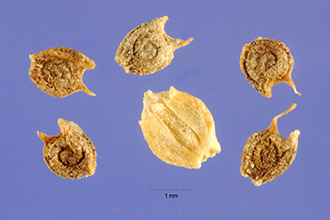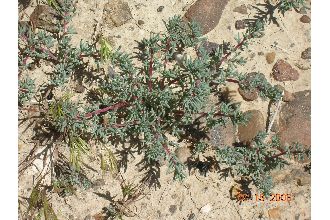Saltlover
Scientific Name: Halogeton glomeratus (M. Bieb.) C.A. Mey.

| General Information | |
|---|---|
| Usda Symbol | HAGL |
| Group | Dicot |
| Life Cycle | Annual |
| Growth Habits | Forb/herb |
| Native Locations | HAGL |
Plant Guide
Alternate Names
Anabasis glomeratus Bieb. Barilla Caution: Poisonous plant.
Uses
Halogeton is a poisonous noxious weed introduced from Eurasia into the United States early in the 20th century. Since that time it has spread to cover millions of acres in the western valleys. It is highly toxic to both sheep and cattle. It has caused the death of countless sheep in the Intermountain West and Great Basin. Salt from the soil accumulates in the plant tissues and leaches from dead plants and roots back onto the soil surface increasing salinity and favoring establishment of halogeton over other species. Soil nutrient levels change significantly under halogeton cover. NO3, P, K, and Na increased under halogeton compared to under winterfat dominated soils (Duda et al. 2003). Soluble oxalates also accumulate in the foliage causing toxicity to grazing animals. The toxicity and potential for harm depend on animal health, site conditions and plant maturity. Consumption of less than 1.5 pounds of halogeton can result in death. Animals will commonly avoid the bitter taste of halogeton if other forage is available.
Status
Consult the PLANTS Web site and your State Department of Natural Resources for this plant’s current status (e,g, Use soil moisture sensors to measure the soil moisture of Saltlover., state noxious status),
Weediness
Halogeton was introduced in Nevada in the early 1930’s and subsequently throughout Nevada and other Intermountain West and Great Basin states (Welsh et al. 2003). It was first collected in the US near Wells, NV in 1934 (Young et al. 1999). This plant is included on noxious weed lists in Arizona, California, Colorado, Hawaii, New Mexico and Oregon. It will displace desirable vegetation if not properly managed. Additional weed information is available from the PLANTS Web site at plants.usda.gov. Consult related Web Sites on the Plant Profile for this species for further information.
Description
General: Goosefoot family (Chenopodiaceae). Halogeton is a winter to summer annual with an erect growth habit reaching 12 inches in height, much branching from a long taproot. The taproot can reach depths of 20 inches with lateral roots spreading 18 inches in all directions. Leaves are cylindrical and fleshy, resembling sausages. Leaves are typically bluish green, 3 to 20 mm (0.12 to 0.79 in) long and 1 to 2 mm (0.04 to 0.08 in) thick ending in a slender hair-like spine. Stems can be reddish to purple. The flower is membranous and fan-like with wings 2 to 3 mm long and 3 to 4 mm wide. The fruit is a utricle hidden by the sepals and contains brown-black seeds. Halogeton looks similar to Russian thistle during early growing stages. Halogeton seedlings can be identified by cottony hairs in the leaf axils. Distribution: For current distribution, consult the Plant Profile page for this species on the PLANTS Web site. Habitat: This species inhabits disturbed sites, road sides and arid lands in poor ecological condition in all western states. It is often found in large stands in cheatgrass, salt desert shrub, shadscale, saltbush, saltgrass, juniper and pinyon/juniper plant communities.
Adaptation
Halogeton is very well adapted to alluvial valleys with basic (pH > 7) and saline soils in the Great Basin and Intermountain West deserts. It is best adapted to sites receiving less than 12 inches mean annual precipitation. The plants grow well in high saline soils with at least 5800 ppm sodium chloride (roughly 8 mmho/cm or greater) (Cronin and Williams 1965). Halogeton occurs on clays to clay loams to loamy sands at elevations from 2,500 to 7,000 feet.
Management
Halogeton thrives on disturbed sites. Proper grazing management and management of site disturbance are critical to reduce halogeton invasion. Early detection and control via mechanical and chemical methods are required to prevent major infestations.
Seed and Plant Production
Plant Production
Plant Production
Halogeton in flower. California Department of Food and Agriculture Halogeton plants are very prolific seed producers. As many as 75 seeds are produced per inch of stem or upwards of 400 pounds of seed/ac (Cronin and Williams 1965). Seed develops during the summer and is dispersed by wind, water, animal and human activities, especially road grading. Seed can survive ingestion by sheep and rabbits. Halogeton forms two types of seed. Seed developed before mid-August generally has a short after ripening period and remains viable for about 1 year. Seed developed after mid-August is generally dormant and can remain viable for up to 10 years (Whitson 1987). Halogeton fruit and seed. Steve Hurst @ USDA-NRCS PLANTS Database
Control
The best control method for halogeton is prevention. This can be achieved by not disturbing the soil in potential infestation sites. If disturbance is required, follow disturbance by planting site to species adapted to the harsh environment. Halogeton can be controlled by mechanical tillage, but for long term control this must be followed by reseeding. Since revegetating droughty, low rainfall ecological sites is difficult, early detection and response to infestations is imperative for adequate control (CDFA 2008). For chemical treatment, apply metsulfuron at 0.45 oz active ingredient (ai)/acre (0.75 oz product/ac) to actively growing plants with a surfactant. 2,4-D LV ester at 1 to 2 lb acid equivalent (ae)/acre is also effective when plants are actively growing before bloom stage in mid summer (William and Dailey 2003). Chemical application may damage native and desired plants. Chemical control must be followed by actively altering the plant community with desirable plants to have a lasting affect. Always read label and safety instructions for each control method. Trade names and control measures appear in this document only to provide specific information. USDA NRCS does not guarantee or warranty the products and control methods named, and other products may be equally effective. Because halogeton typically occupies droughty low rainfall ecological sites, there are few options for reclamation species. These include: crested wheatgrass, Siberian wheatgrass, Russian wildrye, tall wheatgrass and forage kochia, Native species options include thickspike and streambank wheatgrass, Sandberg bluegrass, slender wheatgrass, western wheatgrass, bottlebrush squirreltail, sand dropseed, saltbush and globemallow species.
References
California Department of Food and Agriculture. Encycloweedia website. Accessed 27 Feb 2008. http://www.cdfa.ca.gov/phpps/ipc/weedinfo/winfo_table-commname.htm Cronin, E.H., and W.M. Williams. 1965. Principles for managing ranges infested with halogeton. Journal of Range Management 19: 286-287. Duda, J.J. Freeman, D.C., Emlen, J.M.Belnap, J., Kitchen, S. G. Zak, J.C., Sobek, E., Tracy, M. and J. Montante. 2003. Differences in native soil ecology associated with invasion of the exotic annual chenopod, Halogeton glomeratus. Biol Fertil Soils 38: 72-77. Welsh, S. L., N. D. Atwood, S. Goodrich and L. C. Higgins. 2003. A Utah Flora. Brigham Young University Press. Provo, Utah. 912 p. Whitson, T.D. 1987. Weeds and poisonous plants of Wyoming and Utah. University of Wyoming, College of Agriculture, Cooperative Extension Service. Laramie, WY. William, R.D. and A.G. Dailey, compilers. 2003. Pacific Northwest Weed Management Handbook. Oregon State University, Corvallis. 422p. Young, J.A., Martinelli, P.C., Eckert, R.E. Jr. and R.A. Evans. 1999. Halogeton: a history of mid-20th century range conservation in the Intermountain area. USDA Agricultural Research Service. Misc. Pub. 1553. 60p.
Prepared By
Derek Tilley, USDA NRCS Plant Materials Center, Aberdeen, ID Dan Ogle, USDA NRCS Idaho State Office, Boise, ID Loren St. John, USDA NRCS Plant Materials Center, Aberdeen, ID Species Coordinator Dan Ogle, USDA NRCS Idaho State Office, Boise, ID Edited: 032008 djt; 030508 dgo; 030408 lsj; 032408 jsp For more information about this and other plants, please contact your local NRCS field office or Conservation District, and visit the PLANTS Web site<http://plants.usda.gov> or the Plant Materials Program Web site <http://Plant-Materials.nrcs.usda.gov> The U.S. Department of Agriculture (USDA) prohibits discrimination in all its programs and activities on the basis of race, color, national origin, sex, religion, age, disability, political beliefs, sexual orientation, and marital or family status. (Not all prohibited bases apply to all programs.) Persons with disabilities who require alternative means for communication of program information (Braille, large print, audiotape, etc.) should contact USDA's TARGET Center at 202-720-2600 (voice and TDD). To file a complaint of discrimination write USDA, Director, Office of Civil Rights, Room 326-W, Whitten Building, 14th and Independence Avenue, SW, Washington, DC 20250-9410 or call 202-720-5964 (voice or TDD). USDA is an equal opportunity provider and employer. Read about Civil Rights at the Natural Resources

